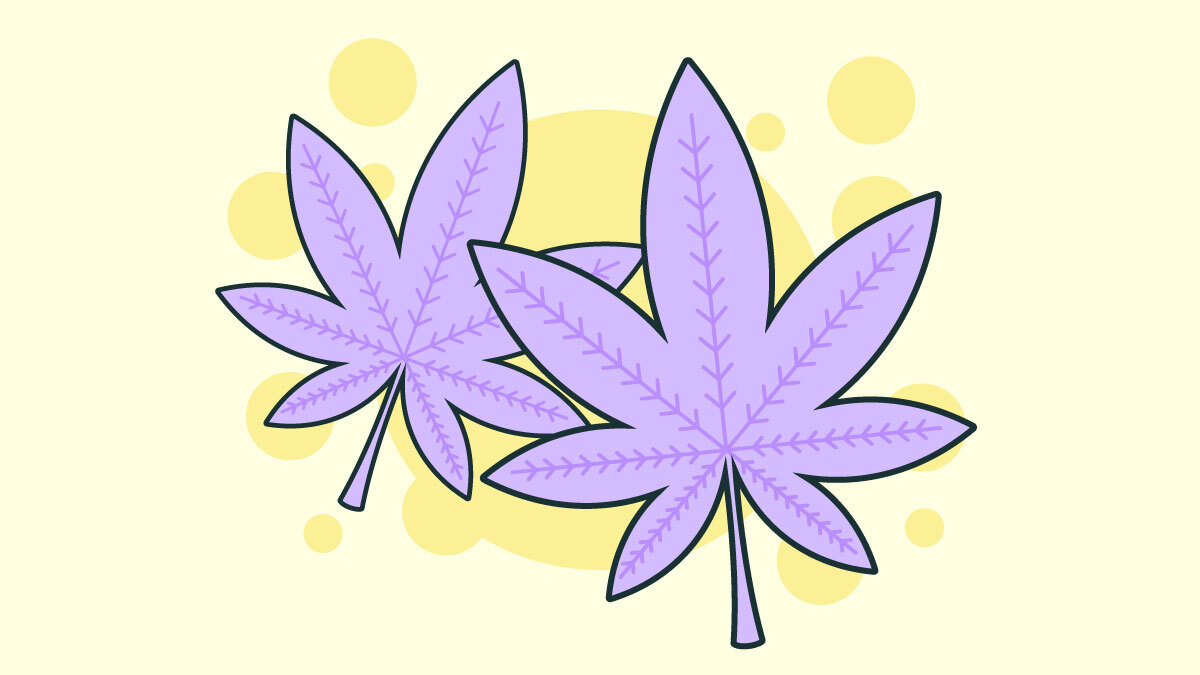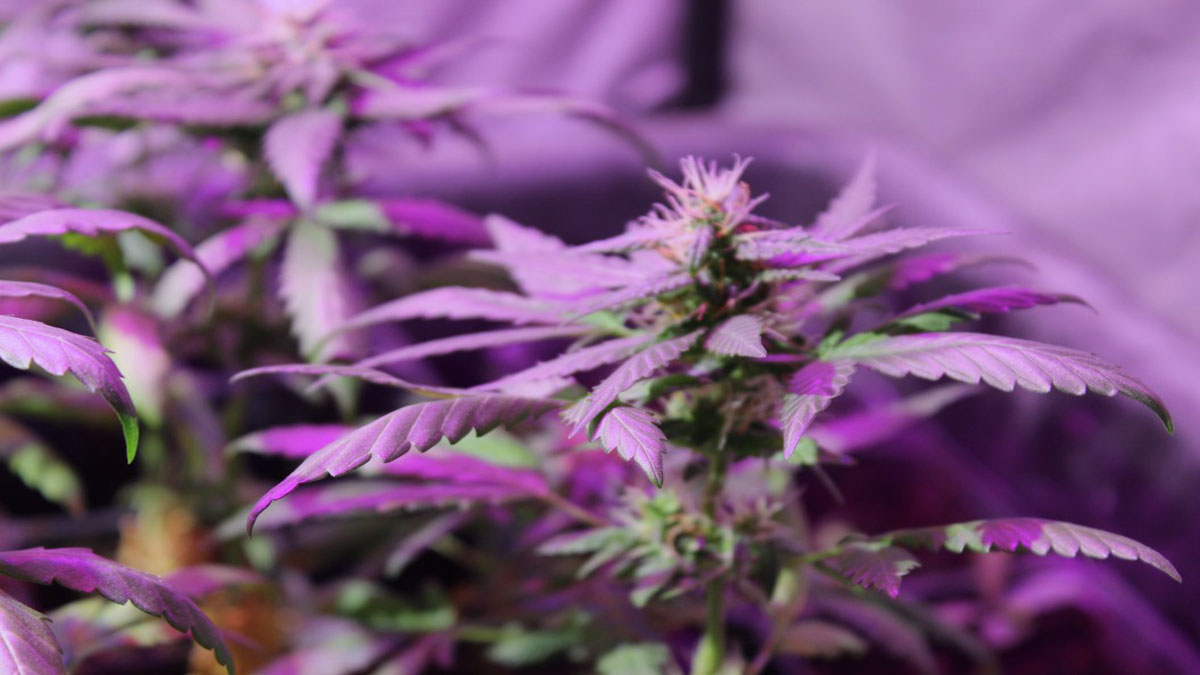What is Purple Cannabis? Why Does Weed Turn Purple?

You’re walking through a dispensary, or a friend shows you the ounce he’s just bought, and you’re captivated by the bright purple color of the beautiful flower.
Does it taste and smell as good as it looks? Is it more potent than the usual green stuff? You’re unable to walk away. You’ve got to try it.
That’s understandable; we all have the same reaction. Purple bud looks fantastic and enticing.
But what’s the story with purple weed? Is it anything special, or is it just pretty?
Why Purple Weed is Purple
There’s a simple reason why some bud is purple. It’s the same reason that blueberries are blue. Anthocyanins get the credit.
What are Anthocyanins?
Anthocyanins are flavonoids present in most plants, and they are quite beneficial for health and wellness. Plants containing them have been used in herbal medicine for centuries.
These flavonoids have anti-inflammatory and anti-microbial properties, and they’re strong antioxidants as well. Anthocyanins are believed to boost cognitive function and have been shown to have neuroprotective properties. They appear to help prevent cardiovascular disease, diabetes, and perhaps even cancer.
That’s not all that anthocyanins do. They’re not just flavonoids, they’re pigments. For example, they’re responsible for the brightly-colored leaves that appear in the fall; as chlorophyll degrades, its green color fades, allowing the colors provided by anthocyanins to shine through. These flavonoids contribute the trademark colors of flowers like lavender and cornflower, too.
Anthocyanins are why blueberries are blue, grapes are red or purple, and radishes are red. They’re also a major reason why so many brightly-colored fruits and vegetables are so good for you; the more anthocyanins in the food, the brighter the color and the healthier it is. The pigments are used as natural dyes and food colorings as well.
That leads to an interesting question. How can a single pigment produce blue, red, or purple colors? It’s because their color is determined by how acidic their environment is. They appear red when pH is low, purple when pH is neutral, and blue when pH is high.
Anthocyanins and Weed
We’ve finally gotten to purple weed. As you probably know, all cannabis contains flavonoids, and many strains contain anthocyanins. As the weather turns colder and plants approach harvest, their chlorophyll degrades. And in plants with bountiful amounts of anthocyanins, the colors provided by those flavonoids appear to the naked eye. Some strains provide the right conditions for the cannabis buds and/or leaves to “become” red, some “become” blue — and some “become” purple. Some may even appear gold or black, depending on the plants’ genetics and whether their acidity is extremely low or high.
That’s a beautiful story. As it happens, though, the color of purple weed isn’t always a simple accident of genetics and biology. These days, breeders are also able to use supplemental grow lights, augment plants’ genetics, and breed new strains specifically to have their attractive purple color.
There are many purple strains of weed. Some, like Granddaddy Purple and Purple Haze (the weed was named after the song, not the other way around), are revered OG strains. Others that aren’t as well-known, like Purple Space Cookies and Grape Skunk, also have a gorgeous purple color.
Is it worth seeking out the purple weed, or paying more for it?
Myth: Purple Weed Hits Harder

In many stoner circles, it’s believed that the purple flower is more potent. We hate to burst that bubble, but it’s simply not true.
Potency is determined by the THC content of a strain, and by the ability of its other cannabinoids, terpenes, and flavonoids to boost its effectiveness through the entourage effect. The presence of anthocyanins does nothing to dramatically change that equation.
To put it simply, potency is determined by genetics and the quality of the plants’ growth. Color may make the pot look better, but it doesn’t signal stronger weed. There’s a possibility that purple flowers may contain less THC.
It’s been shown that exposing marijuana plants to cold temperatures at the end of the flowering state can accentuate the color in purple strains. That may make the cannabis look even prettier (and smell better), but extreme cold can slow plants’ metabolism — which in turn may slow or even stop the production of cannabinoids.
Some growers claim their experience shows that purple strains are naturally less potent. They theorize that the plants have to expend some of their energy to “turn purple,” leaving less energy for the production of trichomes containing THC and terpenes. These growers say they have to put more care into the cultivation of purple strains to overcome the problem.
Make no mistake, though, a lot of growers put that extra effort into breeding and growing purple weed because it’s so popular at the retail level. Ironically, that may explain how the purple flower got its reputation as being potent. If buyers will pay higher prices for purple strains with high THC content, cultivators now can crossbreed strains to produce what the market demands.
There is one common fact about purple weed strains, though: they tend to be Indica or Indica-dominant.
That makes sense. As we’ve mentioned, cooler weather tends to bring out the plants’ purple color. Hardier Indica plants are more likely than Sativa plants to thrive in those temperatures, and many purple strains trade their lineage back to cooler Asian climates.
Speaking of purple strains, let’s talk about a few of them.
Most Popular Purple Weed Strains
We were going to call this section “best purple weed strains,” but changed our minds. The “best” weed is a matter of personal preference.
So we’re going with the most popular purple strains instead:
1. Grape Ape
A relaxing strain with a strong grape smell and THC content approaching 20%, great for pain and anxiety.
2. Purple Urkle
The grape taste comes through strongly, and the properties are similar to those of Grape Ape; it may knock you out in a hurry.
3. Granddaddy Purple
The beloved GDP strain is known for its euphoric, calming high, its delicious grape/berry aroma, and its pain-relieving properties.
4. Purple Kush
Smells, tastes, and acts like a Kush, with slightly more THC than the first four strains on our list; expect total relaxation along with a euphoric head high.
5. Purple Haze
This is the only Sativa-dominant hybrid on our list (the others are indicas), and the strain is revered for its cerebral and uplifting effects.
Purple Weed FAQ
Q: Can you turn a weed plant purple if you pour freezing water on it?
A: Some home growers try this, and it might help bring out the purple color in strains with high levels of anthocyanins and a neutral pH. Here’s the problem: the shock could also kill the plant. That usually won’t happen, but freezing the plant is likely to lower its potency.
Q: Is there a better way for home growers to highlight the purple color in buds?
A: Gradually lowering nighttime temperatures in the few days before harvest has worked for some people. If you’re going to try it, don’t do it for a longer period, and don’t let the temperature go below 50°.
Q: Is there any reason to avoid buying purple flower?
A: Not if you’re buying from a dispensary or a reputable dealer. Otherwise, check the bud carefully before purchasing; some disreputable growers or sellers will use food coloring to turn their weed purple to get a higher price.
References
- Konczak, I., & Zhang, W. (2004). Anthocyanins—more than nature’s colors. Journal of Biomedicine and Biotechnology, 2004(5), 239.[1]
- Khoo, H. E., Azlan, A., Tang, S. T., & Lim, S. M. (2017). Anthocyanidins and anthocyanins: colored pigments as food, pharmaceutical ingredients, and the potential health benefits. Food & nutrition research, 61(1), 1361779. [2]
- Wahyuningsih, S., Wulandari, L., Wartono, M. W., Munawaroh, H., & Ramelan, A. H. (2017, April). The effect of pH and color stability of anthocyanin on food colorant. In IOP conference series: Materials science and engineering (Vol. 193, No. 1, p. 012047). IOP Publishing.
- Ferber, S. G., Namdar, D., Hen-Shoval, D., Eger, G., Koltai, H., Shoval, G., … & Weller, A. (2020). The “entourage effect”: terpenes coupled with cannabinoids for the treatment of mood disorders and anxiety disorders. Current Neuropharmacology, 18(2), 87-96. [4]